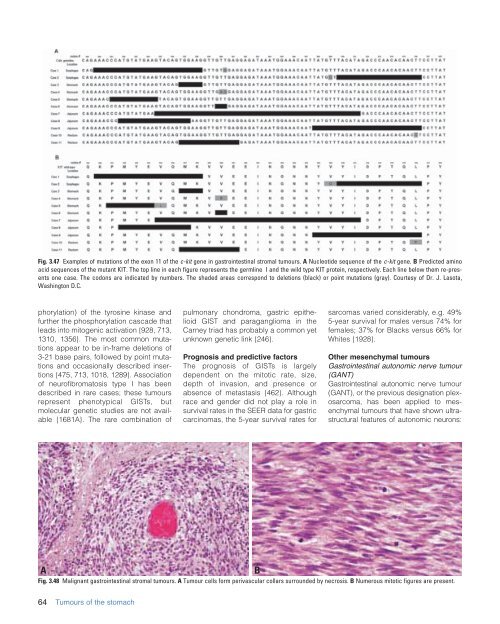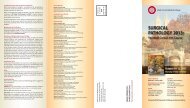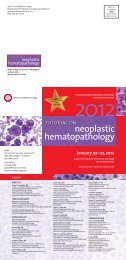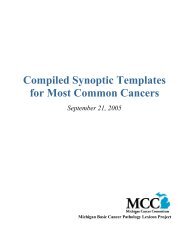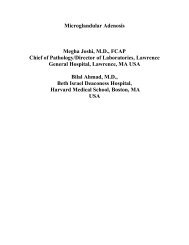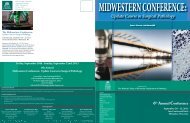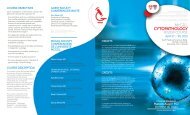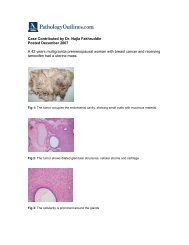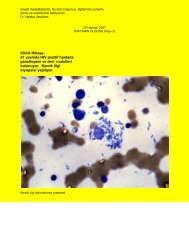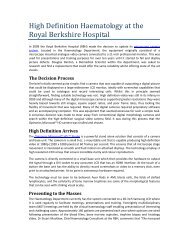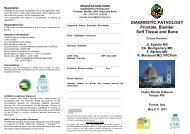CHAPTER 3 Tumours of the Stomach - Pathology Outlines
CHAPTER 3 Tumours of the Stomach - Pathology Outlines
CHAPTER 3 Tumours of the Stomach - Pathology Outlines
You also want an ePaper? Increase the reach of your titles
YUMPU automatically turns print PDFs into web optimized ePapers that Google loves.
Fig. 3.47 Examples <strong>of</strong> mutations <strong>of</strong> <strong>the</strong> exon 11 <strong>of</strong> <strong>the</strong> c-kit gene in gastrointestinal stromal tumours. A Nucleotide sequence <strong>of</strong> <strong>the</strong> c-kit gene. B Predicted amino<br />
acid sequences <strong>of</strong> <strong>the</strong> mutant KIT. The top line in each figure represents <strong>the</strong> germline I and <strong>the</strong> wild type KIT protein, respectively. Each line below <strong>the</strong>m re-presents<br />
one case. The codons are indicated by numbers. The shaded areas correspond to deletions (black) or point mutations (gray). Courtesy <strong>of</strong> Dr. J. Lasota,<br />
Washington D.C.<br />
phorylation) <strong>of</strong> <strong>the</strong> tyrosine kinase and<br />
fur<strong>the</strong>r <strong>the</strong> phosphorylation cascade that<br />
leads into mitogenic activation {928, 713,<br />
1310, 1356}. The most common mutations<br />
appear to be in-frame deletions <strong>of</strong><br />
3-21 base pairs, followed by point mutations<br />
and occasionally described insertions<br />
{475, 713, 1018, 1289}. Association<br />
<strong>of</strong> neur<strong>of</strong>ibromatosis type I has been<br />
described in rare cases; <strong>the</strong>se tumours<br />
represent phenotypical GISTs, but<br />
molecular genetic studies are not available<br />
{1681A}. The rare combination <strong>of</strong><br />
pulmonary chondroma, gastric epi<strong>the</strong>lioid<br />
GIST and paraganglioma in <strong>the</strong><br />
Carney triad has probably a common yet<br />
unknown genetic link {246}.<br />
Prognosis and predictive factors<br />
The prognosis <strong>of</strong> GISTs is largely<br />
dependent on <strong>the</strong> mitotic rate, size,<br />
depth <strong>of</strong> invasion, and presence or<br />
absence <strong>of</strong> metastasis {462}. Although<br />
race and gender did not play a role in<br />
survival rates in <strong>the</strong> SEER data for gastric<br />
carcinomas, <strong>the</strong> 5-year survival rates for<br />
sarcomas varied considerably, e.g. 49%<br />
5-year survival for males versus 74% for<br />
females; 37% for Blacks versus 66% for<br />
Whites {1928}.<br />
O<strong>the</strong>r mesenchymal tumours<br />
Gastrointestinal autonomic nerve tumour<br />
(GANT)<br />
Gastrointestinal autonomic nerve tumour<br />
(GANT), or <strong>the</strong> previous designation plexosarcoma,<br />
has been applied to mesenchymal<br />
tumours that have shown ultrastructural<br />
features <strong>of</strong> autonomic neurons:<br />
A<br />
Fig. 3.48 Malignant gastrointestinal stromal tumours. A Tumour cells form perivascular collars surrounded by necrosis. B Numerous mitotic figures are present.<br />
B<br />
64 <strong>Tumours</strong> <strong>of</strong> <strong>the</strong> stomach


